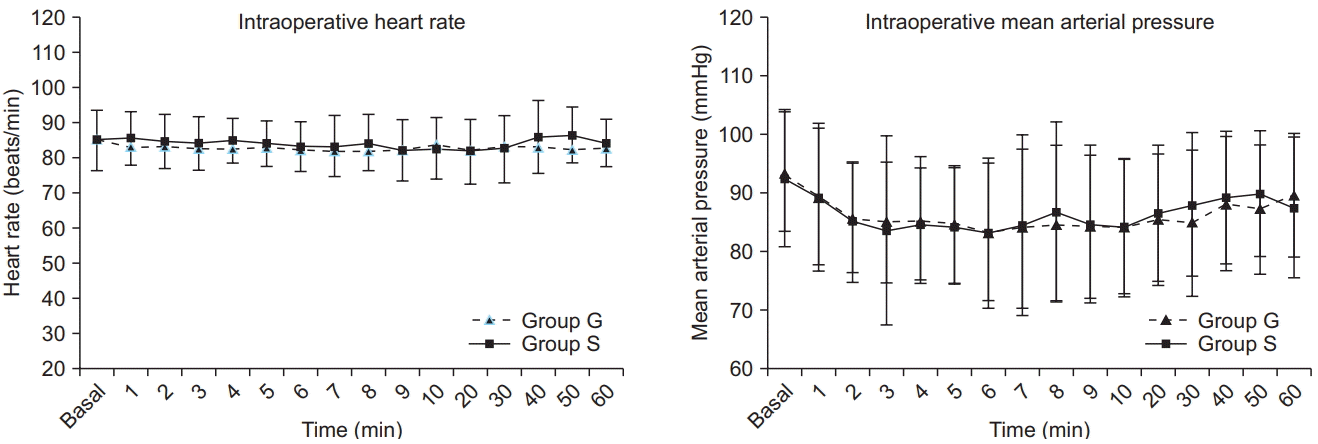1. Helmy SA, Wahby MA, El-Nawaway M. The effect of anaesthesia and surgery on plasma cytokine production. Anaesthesia. 1999; 54:733–8.

2. Cruickshank AM, Fraser WD, Burns HJ, Van Damme J, Shenkin A. Response of serum interleukin-6 in patients undergoing elective surgery of varying severity. Clin Sci (Lond). 1990; 79:161–5.

3. Reith HB, Kaman S, Mittelkötter O, Kilic Y, Kozuschek W. Cytokine activation in patients undergoing open or laparoscopic cholecystectomy. Int Surg. 1997; 82:389–93.
4. Iwase M, Kondo G, Watanabe H, Takaoka S, Uchida M, Ohashi M, et al. Regulation of Fas-mediated apoptosis in neutrophils after surgeryinduced acute inflammation. J Surg Res. 2006; 134:114–23.

5. Ogawa K, Hirai M, Katsube T, Murayama M, Hamaguchi K, Shimakawa T, et al. Suppression of cellular immunity by surgical stress. Surgery. 2000; 127:329–36.

6. Ni Eochagain, Burns D, Buggy DJ. Effect of anaesthetic technique during primary breast cancer surgery on neutrophil-lymphocyte ratio, platelet-lymphocyte ratio, and time of commencement of intended oncologic therapy: a follow-up analysis of a prospective randomised trial. Br J Anaeth. 2018; 120:e2. –3.
7. Papa A, Emdin M, Passino C, Michelassi C, Battaglia D, Cocci F. Predictive value of elevated neutrophil-lymphocyte ratio on cardiac mortality in patients with stable coronary artery disease. Clin Chim Acta. 2008; 395:27–31.

8. Forget P, Machiels JP, Coulie PG, Berliere M, Poncelet AJ, Tombal B, et al. Neutrophil:lymphocyte ratio and intraoperative use of ketorolac or diclofenac are prognostic factors in different cohorts of patients undergoing breast, lung, and kidney cancer surgery. Ann Surg Oncol. 2013; 20 Suppl 3:S650–60.

9. Alkan M, Erkent FD, Celik A, Gokce A, Arslan M, Unal Y. Effects of thoracic epidural or intravenous analgesia on the neutrophil-tolymphocyte ratio in thoracotomy cases. Niger J Clin Pract. 2018; 21:1337–40.
10. Alexander NI. Reference values of neutrophil-lymphocyte ratio, platelet-lymphocyte ratio and mean platelet volume in healthy adults in north central nigeria. J Blood Lymph. 2016; 6:143.

11. Lee JS, Kim NY, Na SH, Youn YH, Shin CS. Reference values of neutrophil-lymphocyte ratio, lymphocyte-monocyte ratio, plateletlymphocyte ratio, and mean platelet volume in healthy adults in South Korea. Medicine (Baltimore). 2018; 97:e11138.

12. Takahashi J, Shono Y, Hirabayashi H, Kamimura M, Nakagawa H, Ebara S, et al. Usefulness of white blood cell differential for early diagnosis of surgical wound infection following spinal instrumentation surgery. Spine (Phila Pa 1976). 2006; 31:1020–5.

13. Kim WH, Jin HS, Ko JS, Hahm TS, Lee SM, Cho HS, et al. The effect of anesthetic techniques on neutrophil-to-lymphocyte ratio after laparoscopy-assisted vaginal hysterectomy. Acta Anaesthesiol Taiwan. 2011; 49:83–7.

14. Forget P, De Kock M. Perspectives in anaesthesia for cancer surgery. J Cancer Res Clin Oncol. 2014; 140:353–9.

15. Stollings LM, Jia LJ, Tang P, Dou H, Lu B, Xu Y. Immune modulation by volatile anesthetics. Anesthesiology. 2016; 125:399–411.

16. Schneemilch CE, Ittenson A, Ansorge S, Hachenberg T, Bank U. Effect of 2 anesthetic techniques on the postoperative proinflammatory and anti-inflammatory cytokine response and cellular immune function to minor surgery. J Clin Anesth. 2005; 17:517–27.

17. Milosavljevic SB, Pavlovic AP, Trpkovic SV, Sekulic AD. Influence of spinal and general anesthesia on the metabolic, hormonal, and hemodynamic response in elective surgical patients. Med Sci Monit. 2014; 20:1833–40.

18. Toman H, Gencer M, Şahin H, Kiraz HA, Şimşek T, et al. The effect of general and spinal anesthesia on neutrophil to lymphocyte ratio in patients undergoing cesarian section. Anaesth Pain Intensive Care. 2015; 19:485–8.
19. Kim MH, Lim KI. The influence of anesthetic technique on the responses of white blood cells and interleukin-6 in patients undergoing low abdominal surgery. Korean J Anesthesiol. 2000; 39:177–82.

20. Kim WH, Jin HS, Ko JS, Hahm TS, Lee SM, Cho HS, et al. The effect of anesthetic techniques on neutrophil-to-lymphocyte ratio after laparoscopy-assisted vaginal hysterectomy. Acta Anaesthesiol Taiwan. 2011; 49:83–7.

21. Forget P, Dinant V, De Kock M. Is the Neutrophil-to-Lymphocyte Ratio more correlated than C-reactive protein with postoperative complications after major abdominal surgery? PeerJ. 2015; 3:e713.

22. Josse JM, Cleghorn MC, Ramji KM, Jiang H, Elnahas A, Jackson TD, et al. The neutrophil-to-lymphocyte ratio predicts major perioperative complications in patients undergoing colorectal surgery. Colorectal Dis. 2016; 18:O236–42.

23. Buyukkocak U, Caglayan O, Daphan C, Aydinuraz K, Saygun O, Agalar F. Similar effects of general and spinal anaesthesia on perioperative stress response in patients undergoing haemorrhoidectomy. Mediators Inflamm. 2006; 2006:97257.








 PDF
PDF Citation
Citation Print
Print





 XML Download
XML Download